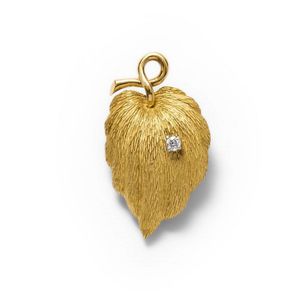Cartier 18ct gold and diamond brooch, of bombe form, the…
Cartier 18ct gold and diamond brooch, of bombe form, the textured leaf is accented with a claw-set brilliant cut diamond, the diamond weighing approximately 0.20 carats, length 50 mm, width 28.5 mm, trombone clip fitting, numbered 2xxx9, signed Cartier.
You must be a subscriber, and be logged in to view price and dealer details.
Subscribe Now to view actual auction price for this item
When you subscribe, you have the option of setting the currency in which to display prices to $Au, $US, $NZ or Stg.
This item has been sold, and the description, image and price are for reference purposes only.
- Claw Set Jewellery - The description "claw set" in jewellery refers to a setting where the gemstone is held in place by metal prongs that resemble claws. These prongs are bent over the edges of the gemstone to secure it in the setting. This type of setting is commonly used for diamonds and other precious stones.
- Bombe Design in Jewellery - In the early 18th century, during the reign of Louis XIV, French court jewellers developed a new style of jewellery called "bombé" because of its bulging, curved shape.
The bombe design can be found in various styles of jewellery, from Georgian, Victorian, Art nouveau, to Art Deco and Retro eras, with the materials and techniques reflecting the era the jewellery was made.
The design is used for rings, bracelets, necklaces and earrings, where a curved or rounded shape is emphasized, giving an organic look to the piece, with the piece often made of gold and set with precious stones, such as diamonds, rubies, emeralds, and sapphires. The bombe design was also paired with other design elements such as engraving, enamelling, or gemstones - Brilliant Cut - In their naturally occuring state diamonds have little life or sparkle and for many centuries were simply cut in half and worn in amulets. Invented at the end of the 17th century by a Venetian diamond cutter, a "brilliant cut" diamond has 58 facets arranged in a regular geometric relationship, with 33 above the crown and 25 below on the pavilion.
The introduction of the brilliant cut increased the popularity of diamonds in jewellery as it was the first cut to reveal the fire of the diamond, with the light being internally reflected from one facet to another, and was superior to the previously used table cut and rose cut.Variants to the brilliant cut have emerged since the end of the 17th century, but the popularity of the original brilliant cut has continued to the present time, where it is still the most commonly found cut.
.
This item has been included into following indexes:
